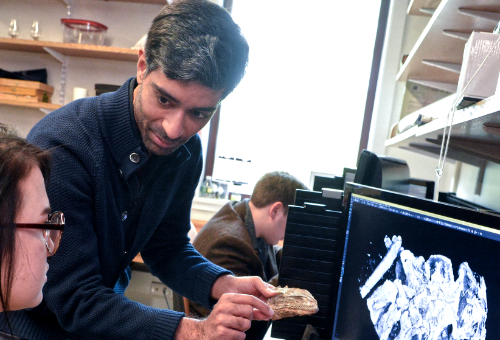What can prehistory tell us about the origins of modern birds? Bhart-Anjan Bhullar from Yale University talks with us about how the discovery of a 95 million year old Ichthyornis fossil in 2014 revealed some unexpected insights into the minds — and mouths — of today’s birds. His article, “Complete Ichthyornis skull illuminates mosaic assembly of the avian head” was published on May 3, 2018 in Nature with Dan Field and six other researchers.
Websites and other resources
Neurocranium of the newly discovered Ichthyornis
- “Evolutionary insights from an ancient bird” (commentary by Kevin Padian on Anjan’s study)
- “Dinosaur-Era Bird Found With Shockingly Intact Skull” (National Geographic discussion with lead author Dan Field)
- “Early Evolution of Modern Birds Structured by Global Forest Collapse at the End-Cretaceous Mass Extinction” (recent study led by Dan Field)
- Extended data and additional figures
- Supplement information (including multiple videos)
- Othneil Charles Marsh biography
- “Early Evolution of Modern Birds Structured by Global Forest Collapse at the End-Cretaceous Mass Extinction” (article by Dan Field and multiple co-authors)
- Related: “Scientists have successfully replicated the molecular processes that led from dinosaur snouts to the first bird beaks” (Yale Department of Geology & Geophysics)
Press Coverage
NPR |BBC | The Guardian | Reuters | Science News | Independent
Bonus Clips
Patrons of Parsing Science gain exclusive access to bonus clips from all our episodes and can also download mp3s of every individual episode.
Support us for as little as $1 per month at Patreon. Cancel anytime.
Patrons can access bonus content here.

We’re not a registered tax-exempt organization, so unfortunately gifts aren’t tax deductible.
Hosts / Producers
Ryan Watkins & Doug Leigh
How to Cite
Watkins, R., Leigh, D., & Bhullar, B.-A.. (2018, July 10). Parsing Science – Prehistoric origins of birds. figshare. https://doi.org/10.6084/m9.figshare.6799199
Music
What’s The Angle? by Shane Ivers



In 1866, Yale University appointed Othniel Charles Marsh as a Professor of Paleontology, the first such professorship in the United States, and only the second in the world at the time. Marsh also was the first to study and name the Ichthyornis. As Anjan is also on faculty at Yale, also an assistant curator for the same museum, and also interested in Ichthyornis, we asked what it’s like serving in such an auspicious capacity.@rwatkins says:
Given the cutting-edge nature of the research that Anjan engages in, Ryan and I were interested in learning if there’s an idea which is prevalent in science that he believes is ready for retirement.@rwatkins says:
In addition to their interest in bones, paleontologists are also concerned with the soft tissue that connects, supports, or surrounds other parts inside the body. While bones fossilize, however, soft tissue doesn’t … leaving researchers to have to infer its form and function. So Doug and I wanted to know what’s so special about soft tissue to paleontologists anyhow. @rwatkins says:
As Anjan discussed, Ichthyornis had much a larger brain than its predecessors. Ryan and I were curious what evolutionary advantages might be experienced by animals with larger brains.@rwatkins says:
Another fascinating aspect of Anjan’s study is that the newly discovered Ichthyornis fossil – the first ever featuring a nearly complete skull – didn’t have the rocky matrix surrounding it removed. Instead, the head of the Ichthyornis was digitally reconstructed in three dimensions using computed tomography – or CT scanning – as Anjan explains next.@rwatkins says:
Anjan and his team’s study is unique not just because of what they found by analyzing the newly discovered Ichthyornis fossil, but also because of what was discovered about earlier specimens that were overlooked by previous researchers. Here, Anjan summarizes the new insights that came from his team’s study.@rwatkins says:
On the “right hand side” of the gap filled by Ichthyornis are modern birds … and, as we all know, birds today have no teeth. A 2014 study found that this may be because modern birds possess a gene that deactivates the formation of teeth … so we have some idea of how birds came to evolve toothless beaks. But Ryan and I wondered why it was that they lost their teeth in the first place.@rwatkins says:
In a May 2018 interview about this study with Rebecca Hersher on NPR, Anjan remarked that "Ichthyornis fills in an important gap, but of course everything that fills a gap makes two more gaps on either side.” Since Doug and I had both listened to the interview when it aired, we were curious to learn what he meant by this.@rwatkins says:
A quick spoiler alert: if you’ve not yet seen the movie Jurassic World, you might want to skip the next 15 seconds or so.@rwatkins says:
While not a dinosaur itself, Ichthyornis lived near the end of the dinosaurs’ reign, about 95 to 83 million years ago, long before humans’ ancestors emerged (sorry Ark players). Ryan and I wondered what life in the Cretaceous period was probably like for the animal.@rwatkins says:
It may come as something of a surprise, that birds – like egg-laying but cold-blooded lizards, snakes, and crocodiles – are also considered reptiles in modern classifications of animal life. Doug and I began our conversation by asking Anjan how it was that he first became interested in the early history of birds.